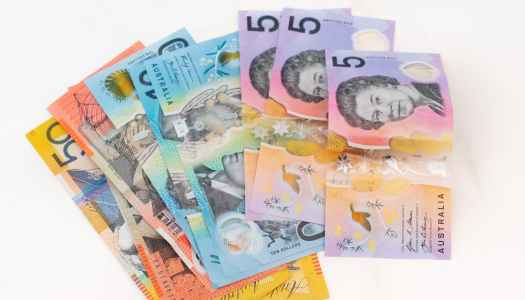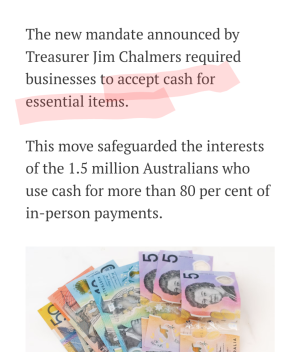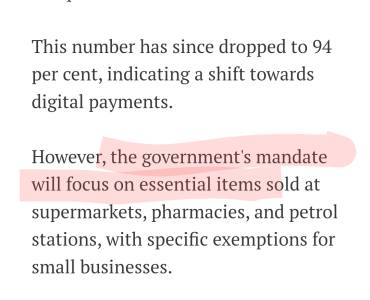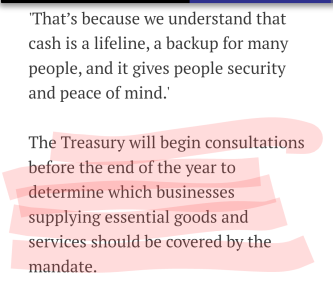New changes to cash payments aim to support vulnerable Australians better—find out why!
By
Gian T
- Replies 34
In an age where digital wallets and contactless payments are becoming the norm, it might seem like cash is on its way out.
However, for many Australians, particularly those over 60, cash remains an essential part of daily life.
Recognising this, the Australian government has taken a significant step to ensure that cash remains a viable payment option, especially for essential purchases.
The new mandate announced by Treasurer Jim Chalmers required businesses to accept cash for essential items.
This move safeguarded the interests of the 1.5 million Australians who use cash for more than 80 per cent of in-person payments.
Before the COVID-19 pandemic, about 99 per cent of businesses accepted cash.
This number has since dropped to 94 per cent, indicating a shift towards digital payments.
However, the government's mandate will focus on essential items sold at supermarkets, pharmacies, and petrol stations, with specific exemptions for small businesses.
'We’re making cash an ongoing feature of our economy even as we modernise the payment system,' Dr Chalmers said.
'That’s because we understand that cash is a lifeline, a backup for many people, and it gives people security and peace of mind.'
The Treasury will begin consultations before the end of the year to determine which businesses supplying essential goods and services should be covered by the mandate.
These discussions will consider the needs of those who rely on cash, including individuals in regional areas and those unable to use digital payments, as well as the impact on small businesses.
The final details of the mandate, which will commence in January 2026, will be announced in 2025.
This gives businesses and consumers ample time to prepare for the changes.
In tandem with the cash payment mandate, the government is also initiating a Cheques Transition Plan.
This plan will phase out cheques, giving customers and businesses until 2029 to adjust to alternative payment methods.
Cheques will only be issued by June 2028 and no longer be accepted by September 2029.
This gradual transition acknowledges the 90 per cent decline in cheque use over the past decade and the fact that many banks and financial institutions are no longer issuing cheques to new customers.
The focus on regional Australia is particularly noteworthy, as the decline of banking services in these areas poses a significant challenge.
The treasurer has emphasised the government's commitment to maintaining decent access and services for Australians living in rural areas.

Do you prefer using cash for transactions, or have you embraced digital payments? How do you think this will impact your shopping habits for essentials? Share your experiences and opinions in the comments below.
However, for many Australians, particularly those over 60, cash remains an essential part of daily life.
Recognising this, the Australian government has taken a significant step to ensure that cash remains a viable payment option, especially for essential purchases.
The new mandate announced by Treasurer Jim Chalmers required businesses to accept cash for essential items.
This move safeguarded the interests of the 1.5 million Australians who use cash for more than 80 per cent of in-person payments.
Before the COVID-19 pandemic, about 99 per cent of businesses accepted cash.
This number has since dropped to 94 per cent, indicating a shift towards digital payments.
However, the government's mandate will focus on essential items sold at supermarkets, pharmacies, and petrol stations, with specific exemptions for small businesses.
'We’re making cash an ongoing feature of our economy even as we modernise the payment system,' Dr Chalmers said.
'That’s because we understand that cash is a lifeline, a backup for many people, and it gives people security and peace of mind.'
The Treasury will begin consultations before the end of the year to determine which businesses supplying essential goods and services should be covered by the mandate.
These discussions will consider the needs of those who rely on cash, including individuals in regional areas and those unable to use digital payments, as well as the impact on small businesses.
The final details of the mandate, which will commence in January 2026, will be announced in 2025.
This gives businesses and consumers ample time to prepare for the changes.
In tandem with the cash payment mandate, the government is also initiating a Cheques Transition Plan.
This plan will phase out cheques, giving customers and businesses until 2029 to adjust to alternative payment methods.
Cheques will only be issued by June 2028 and no longer be accepted by September 2029.
This gradual transition acknowledges the 90 per cent decline in cheque use over the past decade and the fact that many banks and financial institutions are no longer issuing cheques to new customers.
The focus on regional Australia is particularly noteworthy, as the decline of banking services in these areas poses a significant challenge.
The treasurer has emphasised the government's commitment to maintaining decent access and services for Australians living in rural areas.
Key Takeaways
- The Australian government is ensuring that cash remains a viable payment method for essential items to support those who rely on banknotes.
- Treasurer Jim Chalmers mentioned that while 94 per cent of businesses accept cash, this figure has dropped from 99 per cent pre-pandemic.
- Consultations will start before the year ends to identify which businesses essential for supplying goods and services should adhere to the cash payment mandate, considering impacts on smaller businesses and people dependent on cash.
- Changes in the payment landscape include a phased-out plan for cheques, with full discontinuation by September 2029.











